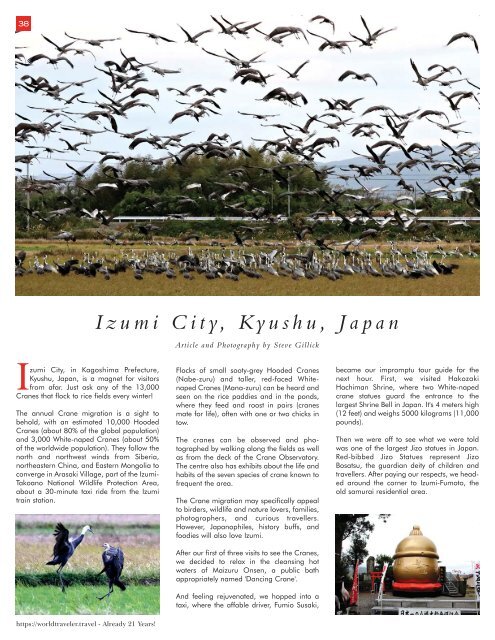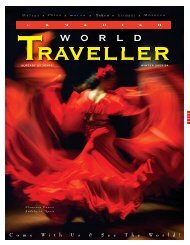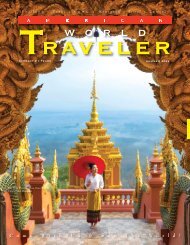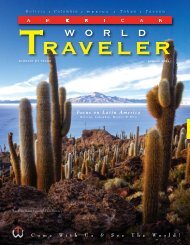Canadian World Traveller Spring 2023 Issue
Now in our 21st year of publishing, Canadian World Traveller explores the culture and history of worldwide destinations, sharing the adventure of discovery with our readers and motivating them to make their travel dreams a reality. Published quarterly, CWT helps sophisticated, independent Canadian travellers choose their next destination by offering a lively blend of intelligent, informative articles and tantalizing photographic images from our World’s best destinations, cruises, accommodations and activities to suit every traveller's taste.
Now in our 21st year of publishing, Canadian World Traveller explores the culture and history of worldwide destinations, sharing the adventure of discovery with our readers and motivating them to make their travel dreams a reality. Published quarterly, CWT helps sophisticated, independent Canadian travellers choose their next destination by offering a lively blend of intelligent, informative articles and tantalizing photographic images from our World’s best destinations, cruises, accommodations and activities to suit every traveller's taste.
Create successful ePaper yourself
Turn your PDF publications into a flip-book with our unique Google optimized e-Paper software.
38<br />
Izumi City, Kyushu, Japan<br />
Article and Photography by Steve Gillick<br />
Izumi City, in Kagoshima Prefecture,<br />
Kyushu, Japan, is a magnet for visitors<br />
from afar. Just ask any of the 13,000<br />
Cranes that flock to rice fields every winter!<br />
The annual Crane migration is a sight to<br />
behold, with an estimated 10,000 Hooded<br />
Cranes (about 80% of the global population)<br />
and 3,000 White-naped Cranes (about 50%<br />
of the worldwide population). They follow the<br />
north and northwest winds from Siberia,<br />
northeastern China, and Eastern Mongolia to<br />
converge in Arasaki Village, part of the Izumi-<br />
Takoano National Wildlife Protection Area,<br />
about a 30-minute taxi ride from the Izumi<br />
train station.<br />
Flocks of small sooty-grey Hooded Cranes<br />
(Nabe-zuru) and taller, red-faced Whitenaped<br />
Cranes (Mana-zuru) can be heard and<br />
seen on the rice paddies and in the ponds,<br />
where they feed and roost in pairs (cranes<br />
mate for life), often with one or two chicks in<br />
tow.<br />
The cranes can be observed and photographed<br />
by walking along the fields as well<br />
as from the deck of the Crane Observatory.<br />
The centre also has exhibits about the life and<br />
habits of the seven species of crane known to<br />
frequent the area.<br />
The Crane migration may specifically appeal<br />
to birders, wildlife and nature lovers, families,<br />
photographers, and curious travellers.<br />
However, Japanophiles, history buffs, and<br />
foodies will also love Izumi.<br />
After our first of three visits to see the Cranes,<br />
we decided to relax in the cleansing hot<br />
waters of Maizuru Onsen, a public bath<br />
appropriately named 'Dancing Crane'.<br />
And feeling rejuvenated, we hopped into a<br />
taxi, where the affable driver, Fumio Susaki,<br />
became our impromptu tour guide for the<br />
next hour. First, we visited Hakozaki<br />
Hachiman Shrine, where two White-naped<br />
crane statues guard the entrance to the<br />
largest Shrine Bell in Japan. It's 4 meters high<br />
(12 feet) and weighs 5000 kilograms (11,000<br />
pounds).<br />
Then we were off to see what we were told<br />
was one of the largest Jizo statues in Japan.<br />
Red-bibbed Jizo Statues represent Jizo<br />
Bosatsu, the guardian deity of children and<br />
travellers. After paying our respects, we headed<br />
around the corner to Izumi-Fumoto, the<br />
old samurai residential area.<br />
https://worldtraveler.travel - Already 21 Years!















